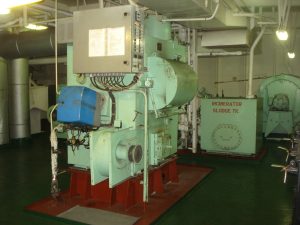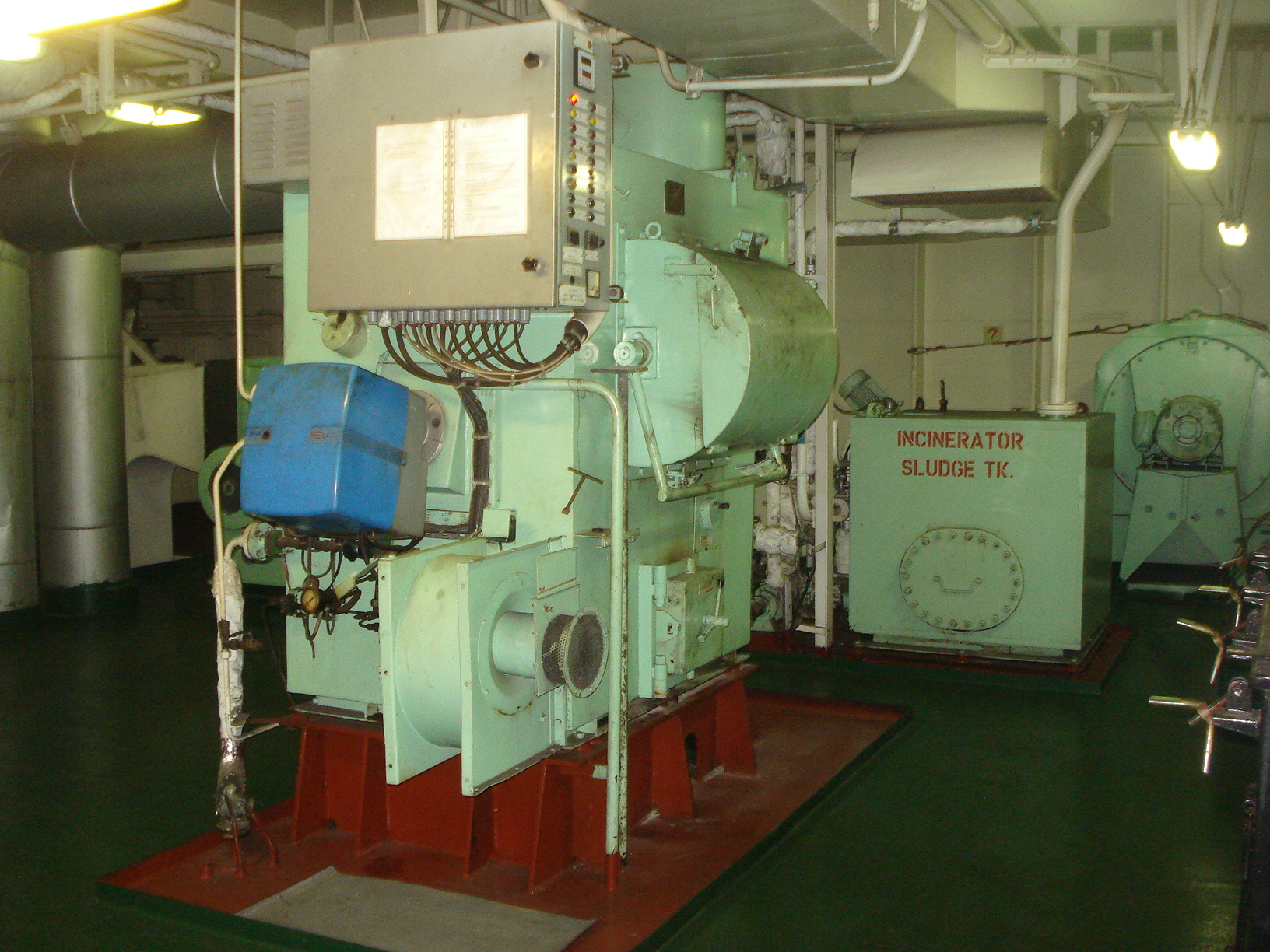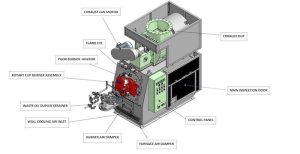Effective waste management on ships is critical to maintaining a clean and compliant marine environment. One of the primary methods of waste disposal onboard is through incineration, where certain types of garbage are burned in specially designed ship incinerators. However, not all waste can be incinerated due to international regulations such as MARPOL Annex V. This guide provides ship cadets and officers with essential knowledge about what garbage can be burned in a ship’s incinerator, best practices, and compliance with maritime environmental regulations.
A ship incinerator is an essential onboard device used to safely dispose of waste generated during maritime operations, including oily sludge, food waste, and other combustible materials. By burning waste at high temperatures, it reduces volume and minimizes environmental impact. The use of ship incinerators is governed by strict regulations under the MARPOL Convention (International Convention for the Prevention of Pollution from Ships), particularly Annex I (oily residues), Annex V (garbage disposal), and Annex VI (air pollution control). MARPOL prohibits the incineration of hazardous materials like plastics containing heavy metals or polychlorinated biphenyls (PCBs) and requires incinerators to be type-approved, operated by trained personnel, and compliant with emission standards. These regulations ensure sustainable waste management at sea, reduce air pollution, and protect marine ecosystems. For ship operators, understanding MARPOL‘s incinerator guidelines is critical for compliance and environmental responsibility.

Understanding Shipboard Incinerators
Ship incinerators are specially designed units that burn waste materials at high temperatures, typically between 850°C and 1200°C, to ensure complete combustion and minimize harmful emissions. These systems help reduce onboard waste volume and prevent illegal disposal at sea, making them an essential part of a ship’s environmental management system.
The MARPOL Convention (International Convention for the Prevention of Pollution from Ships) sets comprehensive regulations for ship incinerators to ensure environmentally safe waste disposal at sea. These rules are primarily outlined in Annex I, Annex V, and Annex VI, each addressing specific aspects of incinerator use and emissions.
1. MARPOL Annex I: Regulation of Oily Residues
Annex I focuses on preventing pollution from oily substances. It permits the incineration of oily residues, such as sludge from fuel and lubricating oil, but under strict conditions:
- Incinerators must be type-approved by the flag state or a recognized classification society.
- Oily residues must be incinerated at temperatures high enough to ensure complete combustion, minimizing harmful emissions.
- Ships must maintain an Oil Record Book to document the incineration of oily wastes, ensuring transparency and compliance.
2. MARPOL Annex V: Garbage Disposal
Annex V regulates the disposal of garbage, including the use of incinerators for burning non-hazardous waste like food waste, paper, and cardboard. Key regulations include:
- Prohibition of incinerating plastics, except in approved incinerators that meet emission standards.
- Ships must follow a Garbage Management Plan and maintain a Garbage Record Book to track waste disposal, including incineration activities.
- Incineration of garbage must be conducted in a manner that prevents pollution and complies with operational guidelines.
3. MARPOL Annex VI: Air Pollution Control
Annex VI addresses air pollution from ships, including emissions from incinerators. It sets stringent standards for incinerator operations:
- Incinerators must be type-approved and meet specific design and operational criteria to control emissions of pollutants like sulfur oxides (SOx), nitrogen oxides (NOx), and particulate matter.
- The incineration of hazardous materials, such as polychlorinated biphenyls (PCBs), heavy metals, and refined petroleum products containing halogen compounds, is strictly prohibited.
- Ships must ensure that incinerators are operated by trained personnel and that combustion temperatures are maintained within specified limits to minimize harmful emissions.
- Annex VI also requires ships to carry an International Air Pollution Prevention (IAPP) Certificate, which includes compliance with incinerator regulations.
General Requirements Across Annexes
- Type Approval: All ship incinerators must be certified and approved by the flag state or a recognized authority.
- Operational Training: Personnel operating incinerators must be adequately trained to ensure proper and safe use.
- Record-Keeping: Ships must maintain detailed records of incineration activities, including the type and quantity of waste burned, in logbooks such as the Oil Record Book, Garbage Record Book, and Engine Logbook.
By adhering to these regulations, ship operators ensure compliance with MARPOL, reduce their environmental footprint, and contribute to the protection of marine ecosystems and air quality. Keywords: MARPOL Annex I, Annex V, Annex VI, ship incinerator regulations, oily residues, garbage disposal, air pollution control, type-approved incinerators, IAPP Certificate.
Credit: Marineinsight
What Garbage Can Be Burned in a Ship’s Incinerator?
According to MARPOL Annex V and Annex VI, only certain types of waste are allowed for incineration onboard ships. These include:
- Food Waste (Non-Plastic Contaminated)
- Organic food scraps and biodegradable kitchen waste that do not contain plastics or toxic substances.
- Helps reduce onboard waste volume before reaching port reception facilities.
- Oily Rags and Oil-Soaked Materials
- Rags and absorbents used for cleaning machinery spaces and engine rooms.
- Must be free from heavy metals or chemicals that produce harmful emissions.
- Waste Oils and Sludge from Machinery Spaces
- Waste lubricants, fuel residues, and oily sludge collected from engine operations.
- These must be processed within IMO-approved incinerators.
- Cardboard and Paper Waste
- Non-laminated cardboard and paper products such as packaging materials and office waste.
- Helps in reducing combustible waste that takes up storage space onboard.
- Cloth and Rope Scraps
- Used cloth, ropes, and natural fiber materials that are non-toxic.
- These must be free from synthetic coatings or plastics.
- Wood and Light Construction Waste
- Untreated wood materials such as crates, pallets, and dunnage used for cargo protection.
- Painted, chemically treated, or varnished wood should not be incinerated due to toxic emissions.
What Garbage CANNOT Be Burned in a Ship’s Incinerator?
To comply with MARPOL regulations, the following materials must not be incinerated:
- Plastics (including PET bottles, synthetic ropes, and plastic packaging) – Produces harmful dioxins and must be disposed of in port reception facilities.
- Heavy Metal Contaminated Waste (such as batteries and electronic components) – Releases toxic fumes and heavy metal pollutants.
- Medical Waste (such as syringes, medical sharps, and biohazard materials) – Requires specialized treatment in designated medical waste facilities.
- Glass and Cans – Non-combustible and should be recycled or disposed of in port facilities.
- Chemical and Hazardous Waste (such as paint residues, solvents, and cleaning chemicals) – Can cause dangerous emissions and reactions in the incinerator.
- PVC and Rubber-Based Products – Releases toxic gases when burned.
To ensure safe and environmentally responsible incineration onboard, ship operators must follow a set of best practices that align with international regulations and promote operational efficiency. First, waste should be sorted properly to separate non-incinerable materials, such as plastics containing heavy metals or hazardous substances, from burnable waste like food scraps, paper, and oily residues. This step is critical to comply with MARPOL Annex V and Annex VI, which prohibit the incineration of certain materials.
Second, it is essential to use IMO-approved incinerators that meet the stringent standards outlined in MARPOL Annex VI. These incinerators are designed to minimize harmful emissions and ensure complete combustion of waste. Additionally, maintaining optimal operating temperatures is crucial; waste should only be burned when the incinerator reaches the recommended temperature range, as this reduces the release of toxic gases and particulate matter.
Operators must also follow the manufacturer’s guidelines for the safe and efficient use of the incinerator. This includes regular maintenance, proper loading procedures, and monitoring combustion performance. Finally, all incineration activities must be accurately recorded in the Garbage Record Book, as required by MARPOL Annex V. This documentation is vital for environmental compliance audits and demonstrates adherence to international regulations. By implementing these best practices, ship operators can ensure safe, efficient, and environmentally compliant waste management at sea.
Shipboard incineration is an essential waste management practice that helps reduce onboard waste, ensuring compliance with international maritime regulations. However, proper segregation, adherence to MARPOL guidelines, and responsible incineration practices are crucial to protecting the marine environment. By following best practices and understanding what can and cannot be incinerated, ship cadets and officers can contribute to more sustainable and compliant maritime operations.
By implementing proper incineration procedures and environmental compliance, vessels can operate more efficiently while reducing their ecological footprint at sea.



Thanks for” What Garbage Can Be Burned in a Ship’s Incinerator”.